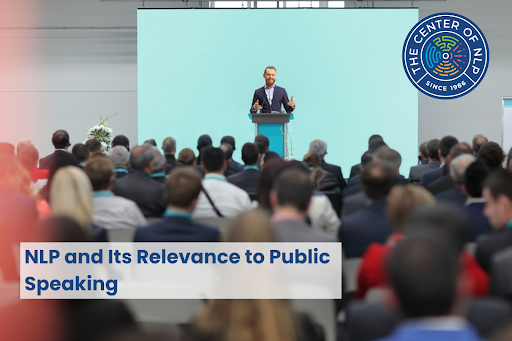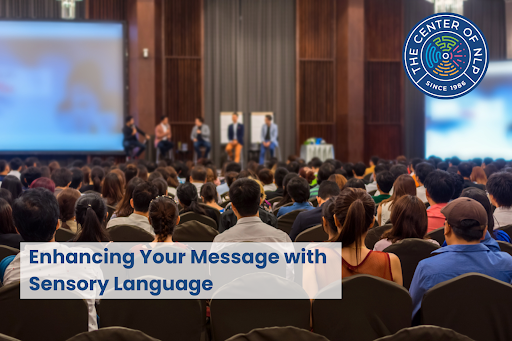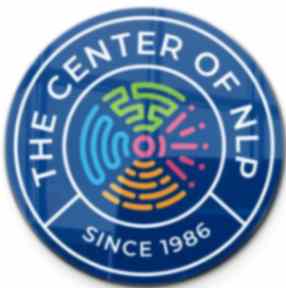CONTACT US [email protected]

How to Enhance Public Speaking with NLP Techniques
Public speaking is an art that demands not only fluency in speaking but also the ability to connect with an audience on a deeper emotional level. Neuro-Linguistic Programming (NLP), a psychological approach that involves how people organize their thinking, feeling, language, and behavior to produce the results they do, offers valuable tools for speakers.
This blog explores how NLP techniques can be used to public speaking skills, making your presentations more impactful and engaging.
NLP and Its Relevance to Public Speaking

NLP stands for Neuro-Linguistic Programming, a methodology developed in the 1970s, which posits that there is a connection between neurological processes, language, and behavioral patterns learned through experience. For public speakers, NLP provides a framework for how verbal and non-verbal communication affects the human brain. By leveraging these insights, speakers can craft their messages more effectively to resonate with their audience.
Building Rapport with the Audience
One of the core principles of NLP is the ability to build rapport with others. Rapport is the foundation of effective communication and is especially crucial in public speaking. It involves creating a mutual sense of trust, making your audience more receptive to your message. Techniques to establish rapport include:
Mirroring and Matching: Subtly mimic the gestures, speech patterns, or posture of your audience. This can make them feel more at ease and connected to you as a speaker.
Eye Contact: Maintain balanced eye contact with your audience. This doesn’t just mean looking at them, but rather engaging with them visually in a way that feels inclusive and attentive.
Use of Language: Utilize words and phrases that resonate with your audience’s background and experiences. This includes using metaphors and analogies that are familiar to the audience’s culture or industry.
Ready to elevate your public speaking skills with expert NLP training for speakers? Visit Center of NLP to discover how our programs can transform your speaking abilities!
Enhancing Your Message with Sensory Language

NLP emphasizes the importance of sensory-based language to tap into the listener's senses. Speakers can communicate by including visual, auditory, and kinesthetic (touch-related) details in their speeches:
Visual: Use descriptive language to create vivid pictures in the mind of the audience. For example, instead of saying, "Our product increases productivity," say, "Imagine your desk at the end of the day, clean and organized, with all your tasks completed."
Auditory: Incorporate sounds into your presentation. Describing a scene with sound effects, like the ringing of a bell or the buzz of a busy office, can make your speech more dynamic and memorable.
Kinesthetic: Appeal to feelings or physical sensations. Phrases like “grasp the idea” or “stay grounded” encourage listeners to engage more fully with the content.
Mastering the Art of Meta-Models and Meta-Programs
Meta-models in NLP are tools that help clarify, challenge, and expand the limits of a person's model of the world. They are particularly useful in public speaking for addressing and overcoming vague language and generalizations in your speech. This precision in communication helps avoid misunderstandings and increases the clarity and impact of your message.
Meta-programs, on the other hand, are mental processes that manage, guide, and direct other mental processes. Utilizing different meta-programs can help you tailor your speech to match the thinking styles of your audience. For instance, Whether your audience prefers big-picture overviews or detailed data can help you structure your presentation accordingly.
Anchoring for Emotional Impact
Anchoring is an NLP technique that involves associating an emotional response with a specific stimulus. For speakers, this means you can 'anchor' your audience's emotional response to your speech or a specific part of it. This could be achieved through a powerful story, a specific gesture, or even a unique word or phrase. When used effectively, anchors can evoke strong emotions and make your message more memorable.
Enhancing Clarity and Precision in Speech

Applying NLP meta-models can significantly improve the clarity and effectiveness of your public speaking. Here’s how you can use meta-models to refine your communication:
Challenge Ambiguities: Identify and clarify any vague statements in your speech. For instance, if you say "Many people like this idea," specify who these people are, why they like it, and how many is "many."
Expand Generalizations: Avoid overgeneralizations by providing specific examples or exceptions. This not only adds depth to your speech but also makes your content more relatable and believable.
Eliminate Distortions:** Ensure that your interpretations or assumptions are supported by facts. This reduces misunderstandings and increases your credibility as a speaker.
Creating Emotional Connections with Anchoring
Anchoring can be a powerful tool to evoke and maintain the audience's emotions throughout your presentation. Here’s how you can effectively use anchoring in your speeches:
Set the Anchor: Choose a moment when your audience is highly engaged or emotionally moved. This could be during a story, a significant statement, or a compelling visual.
Trigger the Anchor: Use a specific gesture, sound, or phrase as your anchor. Consistently use this anchor when you want to evoke a particular emotion or response.
Reinforce the Anchor: Revisit the anchor periodically throughout your speech to reinforce the emotional state. This helps keep the audience connected and engaged with your message.
NLP Training for Speakers
NLP training can provide speakers with the tools they need to improve their delivery, persuasion, and audience engagement. Here are key aspects of NLP training tailored for public speakers:
Behavioral Patterns: Learn how to read and adapt to the behavioral patterns of your audience, enhancing engagement and response.
Improving Language Patterns: Master language structures that can influence and motivate audiences, using techniques such as pacing and leading.
Handling Stage Fright: Utilize NLP strategies to manage and overcome nervousness, allowing for a more confident and impactful presentation.
NLP Techniques for Public Speaking
Applying specific NLP techniques can greatly your public speaking skills by making your messages more compelling and memorable. Here are some effective NLP techniques for speakers:
Reframing: Learn how to change the context or perspective of a message to influence and engage the audience positively.
Storytelling with NLP: Utilize NLP methods to craft stories that resonate deeply, ensuring your key points are remembered long after the speech ends.
Sensory Acuity: Develop your ability to notice and respond to non-verbal feedback from your audience, adjusting your approach in real time to maintain engagement.
Wrapping up!
Incorporating NLP techniques into your public speaking practices can profoundly impact your effectiveness as a communicator. By applying concepts like rapport-building, sensory language, meta-models, and anchoring, you can deliver speeches that are not only informative but also deeply engaging and persuasive.
As with any skill, mastery of NLP in public speaking comes with practice and dedication, so continue to refine these techniques and watch your public speaking prowess grow.
Two, would you like to learn how to use neuro-linguistic programming (NLP) approaches when speaking in front of an audience? Learn all you need to know about public speaking at the Center of NLP's extensive training program.
Check Out For more:
Copyright 1989 - 2024 | The Center of NLP © | All Rights Reserved

